|
Posted on 10/21/2003 12:02:11 AM PDT by SAMWolf
|
|
 are acknowledged, affirmed and commemorated.
|

| Our Mission: The FReeper Foxhole is dedicated to Veterans of our Nation's military forces and to others who are affected in their relationships with Veterans. In the FReeper Foxhole, Veterans or their family members should feel free to address their specific circumstances or whatever issues concern them in an atmosphere of peace, understanding, brotherhood and support. The FReeper Foxhole hopes to share with it's readers an open forum where we can learn about and discuss military history, military news and other topics of concern or interest to our readers be they Veteran's, Current Duty or anyone interested in what we have to offer. If the Foxhole makes someone appreciate, even a little, what others have sacrificed for us, then it has accomplished one of it's missions. We hope the Foxhole in some small way helps us to remember and honor those who came before us.
|
|
The Solomon Islands campaign began with the taking of Guadalcanal in December 1942. In February 1943 the Russell Islands fell, and the New Georgia group followed in August 1943. At the end of 1943, the campaign reached its goal when American troops gained a solid foothold on the island of Bougainville. The Russells, New Georgia and Bougainville were objectives because of their value as air bases.  The objective of the Solomon Islands campaign was to cut off Japan's major forward air and naval base at Rabaul, on the island of New Britain. Rabaul was the hub of Japanese air power in the south Pacific--a stopping point for planes coming from New Guinea in the southwest and Truk, the home of the Japanese Combined Fleet, in the south central Pacific. Bougainville was key to neutralizing Rabaul. The first attack on Bougainville occurred Aug. 15, 1943. Eight Corsairs from Marine Fighter Squadron 214 (later known as the Black Sheep) flew up from the Russell Islands to strafe the Kahili airfield during American amphibious landings on the island of Vella Lavella. The lightning strike--a surprise so complete the Japanese did not have time to shoot back--damaged aircraft and refueling equipment on the ground and forestalled a night attack on the American amphibious force.  The Solomon Islands air defenses (AirSols), including units from the Navy, Marine Corps, Army and Royal New Zealand Air Force, made many air strikes in October on Bougainville and nearby islands. Although some strikes were designed to keep the enemy guessing as to the Marines' intended landing point, most were planned to reduce air opposition to the Bougainville landings when they finally occurred. Two diversionary amphibious landings were made the night of Oct. 27-28: the 2nd Marine Parachute Battalion landed on Choiseul; and New Zealand's 8th Brigade, together with Navy Seabees (U.S. Naval Construction Battalions), made an unopposed landing on the Treasury Islands on Oct. 27. Both operations served their primary purpose of drawing Japanese troops away from Bougainville, but the positions gained in the Treasuries, including valuable Blanche Harbor, were held and strengthened to provide staging for the landings on Bougainville. The Marines left Choiseul by landing craft after a week of harassing Japanese troops and damaging barge and supply bases. Admiral William F. Halsey, Commander South Pacific, ordered Task Force 39 (which included four cruisers and the eight destroyers of Captain Arleigh Burke's Destroyer Squadron 23), under Rear Admiral A.S. Merrill, to bombard airfields on Buka and Bonis northwest of Bougainville. He intended the bombardments to keep the enemy off-balance and prevent air harassment of the landing force. The task force then steamed more than 200 miles to strike at the Shortland Islands, while Rear Admiral F.C. Sherman's Task Force 38 took over the bombardment of Buka, eliminating the threat from those airfields.  U.S. troops go over the side of a Coast Guard manned combat transport to enter the landing barges at Empress Augusta Bay, Bougainville, as the invasion gets under way. The actual landing by the 3rd Marine Division at Empress Augusta Bay took place at dawn Nov. 1. The bay, located at some distance from the heavily defended airfields at either end of the island, had what appeared to be the most suitable beaches for a landing. The plan was to establish a beachhead, then bring in supplies and equipment to build a landing strip for fighters. Invasion forces consisted of 14,321 troops (including the 1st Marine Dog Platoon with their 24 Dobermans and German shepherds) in 12 transports, preceded by a minesweeper group. Destroyer Squadron 45, four minelayers and two salvage tugs provided further support. The landing met with several obstacles. The Japanese defense of the beaches was stronger than anticipated. The 40,000 troops on the island had been reported stationed mainly around the airfields, and aerial reconnaissance photos did not reveal the extensive system of bunkers in the jungles above the beaches. The Marines who landed west of the mouth of the Koromokina River encountered steep slopes and shoals on which more than 80 of their amphibious craft foundered. Those landing east of the Koromokina were caught in crossfire from machine guns on the offshore islet of Puruata and on Cape Torokina east of the beach. A small contingent of Marines knocked out the gun emplacement on the cape after it had destroyed or damaged 14 landing craft; the 3d Marine Raiders captured Puruata.  A typical Japanese pillbox The landing force drove away the rest of the Japanese defenders, while the dog platoon, moving ahead of the main body, sniffed out snipers along the trails of the bog-ridden jungle. In spite of the resistance, and two Japanese air assaults launched from Rabaul bases during the day (which were driven off by AirSols fighters), the Marines succeeded. By nightfall, all 14,000 troops, together with 6,200 tons of fuel, rations, and ammunition, were landed along a 200-yard perimeter. The evening of the landing, Army reconnaissance aircraft reported that a large Japanese surface force was heading for Bougainville. Task Force 39 intercepted it about 2:30 the following morning 45 miles west of Empress Augusta Bay. The American ships, executing maneuvers at breakneck speeds in the darkness to avoid Japanese long-range torpedoes, sank two enemy ships after three hours of heavy fire. With two other ships damaged in collisions while trying to avoid American torpedoes, the scattered Japanese chose to retreat. The American force had only two ships hit, both of which sustained moderate damage. The initial Japanese reaction to the Bougainville landing was to send a force of 19 ships to strengthen Rabaul. However, a Nov. 5 air attack from Task Force 38 heavily damaged seven cruisers and two destroyers, prompting the withdrawal of the cruisers and eliminating worries about surface attacks on the Bougainville amphibious forces.  Even so, the night of Nov. 6-7, four Japanese destroyers eluded the Americans and landed 475 troops west of the Marine beachhead. The Japanese hoped to catch the Marines between them and the other troops on the island, but the enemy forces never coordinated their actions. The Marines routed out the counter-landing detachment after two days of artillery barrages. Fewer than 100 Japanese escaped into the jungle; the rest were killed. The Marines sustained under 50 casualties. Another punishing attack from Task Force 38 on Rabaul Nov. 11 cost the Japanese 68 fighters and three ships. Nevertheless, Japanese carrier air groups from Rabaul made repeated attacks on the American landing force and the U.S. Navy ships, which continued to ferry in reinforcements, supplies and munitions. The strikes did little damage to the American forces, but the Japanese lost so many planes--121 out of 173--that the remaining carrier-based squadrons were withdrawn Nov. 13. By that time, the Americans had landed nearly 34,000 troops and over 23,000 tons of cargo on Bougainville, widened the beachhead 7,000 yards, and moved 5,000 yards inland through dense, difficult mangrove swamps.  Blood plasma literally puts new life into the veins of a wounded Marine at Bougainville. Donated in the United States, and often flown to the front, plasma saves countless lives that would be lost without it. Even though two airfields were under construction and the Marines were expanding their perimeter in search of a site to build a bomber strip, the Japanese army commander on Bougainville still believed that the landing was a feint. He continued to think that the primary targets were Buka to the north and the Buin section of the island to the southeast. Thus, no Japanese forces were withdrawn from either end of the island to root out the American invasion, and the Americans had the opportunity to solidify their positions. On Thanksgiving Day, Nov. 25, Burke's DesRon 23 fought the Battle of Cape St. George, sinking three Japanese vessels out of five sent with troops to reinforce Buka. The American ships suffered no hits at all. The same day, the Marines pushing inland along the Piva River virtually destroyed the 23rd Imperial Infantry in the Battle of Piva Forks. This was the last major Japanese ground resistance on Bougainville. On Christmas Day, the Army's Americal Division arrived on Bougainville to relieve the 3rd Marine Division. Marine Major General R.J. Mitchell, ComAirSols, moved his headquarters to Bougainville to direct the final air campaign against Rabaul, only 220 miles away. Within a month, the base at Rabaul was of no further use to the Japanese.  Negro troops of the 24th Infantry, attached to the Americal Division, wait to advance behind a tank assault on the Japanese, along Empress Augusta Bay on Bougainville. American troops continued to occupy Bougainville, and contain dwindling Japanese troops, until relieved by Australian II Corps troops in late 1944. The Australians attempted to clear the entire island of Japanese, incurring heavy casualties. The end of the Pacific war brought and end to action on Bougainville. The Bougainville campaign remains one of the most resounding successes of the war in the Pacific in terms of the smooth coordination between the Navy and Marine Corps. The capture of Bougainville successfully isolated Rabaul. In the fight for Bougainville, the Japanese expended more of their air units than they could afford to lose. The Bougainville airstrips constructed at Torokina and Piva by Seabees and engineers made possible fighter-escorted bomber attacks against Rabaul, and other Japanese bases on New Ireland and New Britain.  Navajo Codetalkers on Bougainville In December 1943, AirSols began a massive attack on Rabaul. The ensuing two months of constant air strikes, made possible by the possession of Bougainville, caused the Japanese to withdraw. The capture of Bougainville caused Marine casualties of 423 dead and 1,418 wounded.
|
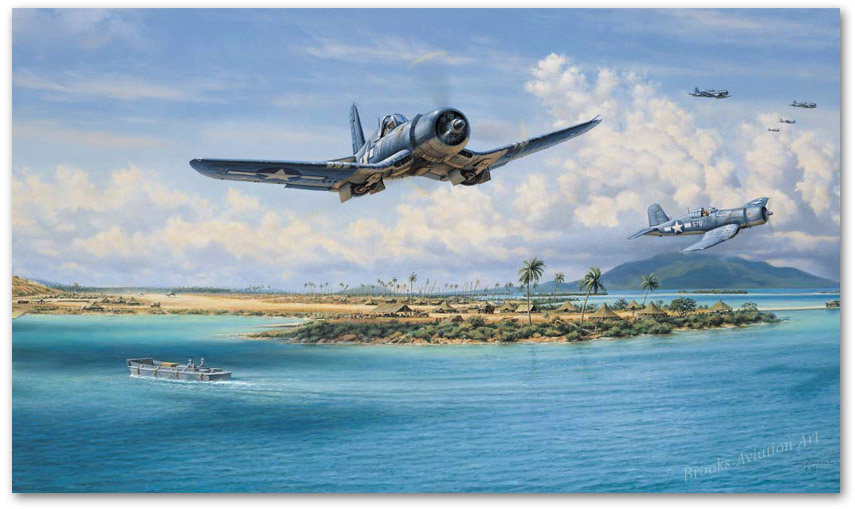
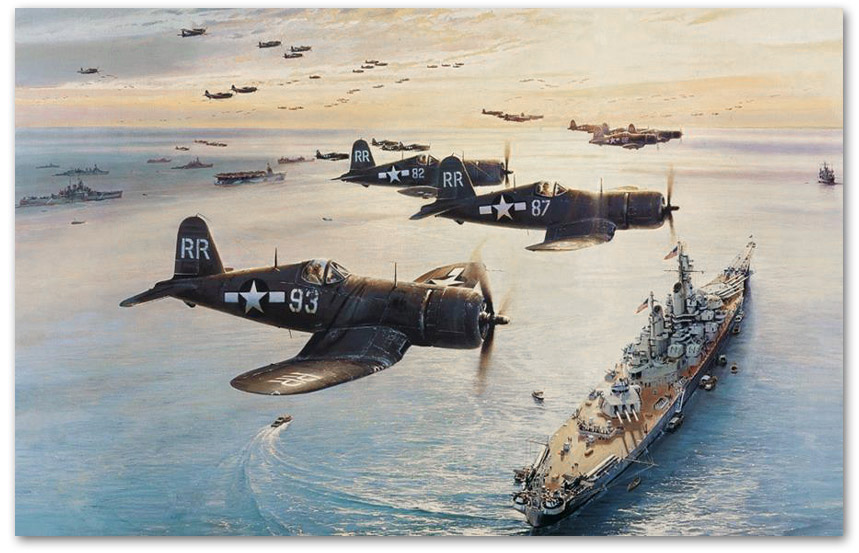



Loved the Corsair pix - definitely one of my all time fave airplanes.

Elements of the Zuikaku Sentoki-Tai (Zuikaku Fighter Force) operated from Buin airfield on Bougainville Island during January and February 1943 while on temporary duty, detached from their ship, the aircraft carrier Zuikaku. This unit claimed about 40 victories while flying aerial cover operations in support of Japanese troop units being evacuated from Guadalcanal. Warrant Officer Shigemi, flying his A6M2 Reisen Type Zero Carrier-Based Fighter Model 21, s/n 6544, tail number AI-1-129, was shot down and killed in combat on February 4, 1943 while flying as a member of the Zuikaku Fighter Force on Bougainville.

Captain McCarthy running for Senate while in Bougainville, Solomon Islands, April 1944

Australian tank deployment
by Graham Donaldson
On Bougainville Island, early 1945
When the Australians under Lieut-General Savige, GOC Second Corps including the AMF (Australian Military Forces) 3 Division and 11Bde & AIF 23 Bde operating in Bougainville and adjacent islands, assumed responsibilities for the Torokina coastal confines the Americans had repulsed two large-scale Japanese counter-attacks. The Japanese commander of the 17Army, Lieut-General Kanda, withdrew his remaining combatants from the American perimeter concentrating them in the south near the garden grown food resources. On the 24 January 1945 the 25Btn relieved the 47Btn on the coastal Tevara River entrance then set off down the west coast of Bougainville and by 3 February a platoon had invested the shoreline village of Toko. That same day another platoon landed from a barge and the combined force carried the patch of ground at the point of a bayonet forcing the overwhelmed elements of the Japanese 13 Regiment to withdraw.
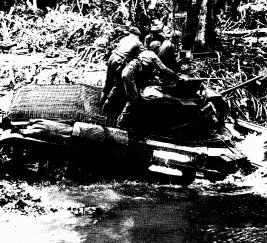
The 15BG insertion at Toko established a base for a new axis of advance to the Hongari and Hari Rivers and to cut the Japanese supply line of the Buin Road the main track on the whole island into Empress Augusta Bay. At 9am on Thursday 29 March 1945 at Toko, and again on Good Friday, advance tanks of ‘B Squadron 2/4AR went ashore from LCT’s (Landing Craft Tank) with Maj Arnott in command and Brig Field ordered the armoured unit to the Puriata River to support the operations now active across to the Buin Road. The manoeuvre was also a chance to demonstrate the effectiveness of employing tanks with forward infantry companies and protection for the line of communications. The following morning 15FldCo engineers, helped by clerks, cooks and other employable locals began improving the three-ton bridge at Combes Crossing and by 2.30pm the 24ton tanks began moving. In the meantime the Puriata River had flash flooded and was too high for the Matildas to ford, there the crews got to work and in half the time prescribed had waterproofed the tanks with canvas and grease. The first tank bogged in the stream, the other three crossed with the aid of a towrope connected to two tracked conventional bulldozers and the Matildas were able to move up behind the 25Btn location at Slater’s Knoll.
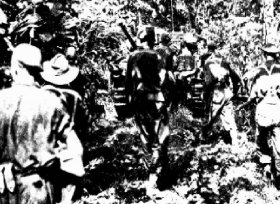
The element of surprise was essential and it was inadvisable to mention the word tank on the unsecured telephone line, so it was asked if "Arnott’s biscuits" had arrived and the reply was they have. Next morning the Matilda’s escorted by infantry, engineers and a bulldozer to improve the track set-off to break the Japanese counter-attack that had invested three companies, and were holding out. In the perimeter the hard-pressed Diggers heard the tank engines roar above the sound of firing weapons as the Japanese launched a last desperate banzai attack. The Matildas rolled forward until 400yards from the area of action, then advancing to the attack went churning down the road with all guns blazing, thrashing the thick vegetation with automatic Besa machine-gun fire and piercing foxholes with quick-fire 2pdr solid shot. The enemy broke into the open and were cut down by the infantry support as they fled. Here the tank force split, a couple of Matildas escorted the wounded back to Slater’s Knoll and the others advanced with B’Company to its old position to recover the heavy equipment. The Japanese ambushed the wounded column but with the timely arrival of the second tank force returning beat back the Japanese attack. The enemy had shown his hand and the order for barbed wire was rushed through with an additional supply air-drop arranged and the Australians dug in.
The defenders did not have to wait long for on the 5 April the Japanese struck in force. Buin Road splits Slater’s Knoll left of centre that is hard up against the west bank bend of the Puriata River. The Japanese for an hour and a half swept up in waves to within yards of the Digger’s forward gun-pits even though the diversionary western flank attack had failed before the main assault developed. The enemy was pinned by 25pdrs that joined in while the Japanese could be heard entrenching along the gully. All morning the boom of mortar bombs and grenades criss-crossed the barbed wire front-line, sporadic banzai attacks were broken up and the wounded evacuated. A little after midday two Matildas moved through to the forward line of the battle to assist the infantry that had now begun to mop up and the small stubborn enemy parties that broke cover as the Infantry tanks drew near were mowed down by automatic weapon fire. The Puriata Line had been held and after four months of fighting the enemy, and the elements, the weary 7Bde was relieved by the 15Bde under Brig Hammer and his brigade were set the task of clearing the Japanese to the Hari River. He also gladly accepted ‘U’ Heavy Battery armed with 155mm Long Tom heavy artillery, they arrived by barge then after settling in joined 2/11FldRgt that had been languishing in Lae and sent across. An encircling move was planned by the commander for the advance east to the Hari River line objective, with the frontal assault along the Buin road by 58/59Btn group under Colonel Mayberry having two troops of tanks commanded by Maj Pike assisting. Simultaneously from the north in the Rumika area deployed west of the Hongari River the 57/60Btn group of about 180 soldiers, one troop of tanks and a platoon of engineers, one bulldozer and some 120 native carriers, was to thrust along the commando bush road through the jungle to the east then cut south in a wide arc onto the enemy’s line of retreat. Still further north an armoured patrol group known as Scott Force which is to advance the direction of Kingori to give northern flank protection.
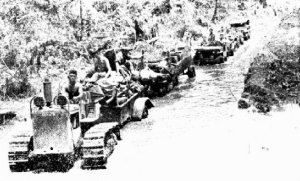
In one action the bulldozer clearing a tributary path had to be abandoned when it bogged drawing a hail of bullets, but with supporting artillery and Corporal Burns’ Matilda advanced to cover the wounded around the bulldozer, which was hooked up and brought to safety. The armoured vehicle crew and those infantry that could be spared often had to corduroy the saturated track with logs before the tank could move through. Another time a concealed Japanese field gun opened fire down the track at the leading tank of Corporal Matheson but the combined return tank salvo promptly silenced it. Unbalanced by these thrusts the Japanese were outflanked and his defences collapsed, with a spectacular advance the Diggers crossed the Hari river, which the enemy had every intention to hold, and arrived on the Ogorata River to within striking distance of the next river the Mobai. In May 1945 the Australians at Bougainville received the HQ and an additional squadron of the 2/4AR. For the first time the bridge laying scissors tank Covenantor Bridgelayer was employed and the Tomoi River was crossed. Also timed concentrations of artillery fire caused disruption amongst the enemy on the receiving end, so defended positions were taken with minimum casualties although ammunition expenditure rose steadily. While the two forward artillery regiments had met the needs of successfully supporting one brigade, the third field regiment was needed to provide relief for those battling over the dense jungle under the extreme equatorial conditions.
By June the troops of 15BG had pushed south east onto the Miva River approaching towards Buin and were relieved by Brig Simpson’s fresh AIF 29Bde. The heavy weight Matilda Mk2’s were used to plough tracks through the thick terrain for the leg patrols but on occasions were badly damaged by being blown up by layed mines hidden beneath the foliage. The enemy even brought forward a 150mm gun and at a range of 350yards hit the leading tank killing the driver Trooper Dew and wounding the rest, the tank was hit twice more and destroyed. The Japanese were starting to improvise anti-tank measures against the threat of thick armoured fighting vehicles. In the operations to the north of the island on the 23 July the 8Btn of the 23Bde under Brigadier Potts attacked Commo Ridge where the Japanese seemed to be establishing themselves strongly. After bombardment by the First Marine Air Wing and RNZAF Corsairs, Capt Reed’s company moved off from the start line with two Matilda tanks belonging to Lieut Scott’s armoured patrol, which had been transferred to this sector early in July. As the joint force got closer to the enemy position one Matilda became stuck, the other had halted on soft swampy ground, nevertheless the tanks were able to give covering cannonade fire in support of the infantry attack and the ridge was taken in twenty minutes. In the same sector on 2 August the lead tank of a 27Btn two company strong patrol along the Ruri Bay track tripped a mine made from a 500lb ariel bomb, killing three of the crew and wounded eight infantrymen. Lieut-General Savige forbade the using of heavily armoured cumbersome Infantry tanks on jungle patrol and be only employed with troops assaulting enemy positions that have been fully investigated. During July only 26 days were wet with 2173 points of rain falling and both sides settled to deep offensive foot patrols with continued Allied ariel superiority until the end of the war.

First Marine Dog Platoon, Bougainville 1944
141. "The Yanks mop up on Bougainville. At night the Japs would infiltrate American lines. At Dawn, the doughboys went out and killed them. This photo shows tank going forward, infantrymen following in its cover." March 1944. 111-SC-189099. (ww2_141.jpg)
Note ejected casing in midair above bayonet-fitted rifle.

An animated pilot describes a recent air battle over Rabaul
Edward Steichen, 1943.

Marine airmen on Bougainville Island relax between strikes on the gull wings of a Corsair fighter.
Fenno Jacobs, 1944.

LVT(A)(1):

Had a M3 light tank turret mounted. Gun used a gyrostabilizer. Also had "manholes" at rear with .30 cal MGs installed. The Marines would replace the 37 mm gun with the E7 flamethrower, and many of these were used at Bougainville and New Georgia.
The flame thrower has caused Tom Daschle to be "deeply saddened."
He is particularly disappointed in the "shameful failure of diplomacy".
Pssst. FDR is a Democrat.
Love the "McCarthy for Senator" picture.
The flame thrower has caused Tom Daschle to be "deeply saddened."
He is particularly disappointed in the "shameful failure of diplomacy".
LOL! I like it when Dashole is saddened, means things are going good for America.
Oh No. Good Luck on getting things straigntened out.
P.S. That advice goes for wives and teenagers too.

Go Yankees!
Disclaimer: Opinions posted on Free Republic are those of the individual posters and do not necessarily represent the opinion of Free Republic or its management. All materials posted herein are protected by copyright law and the exemption for fair use of copyrighted works.